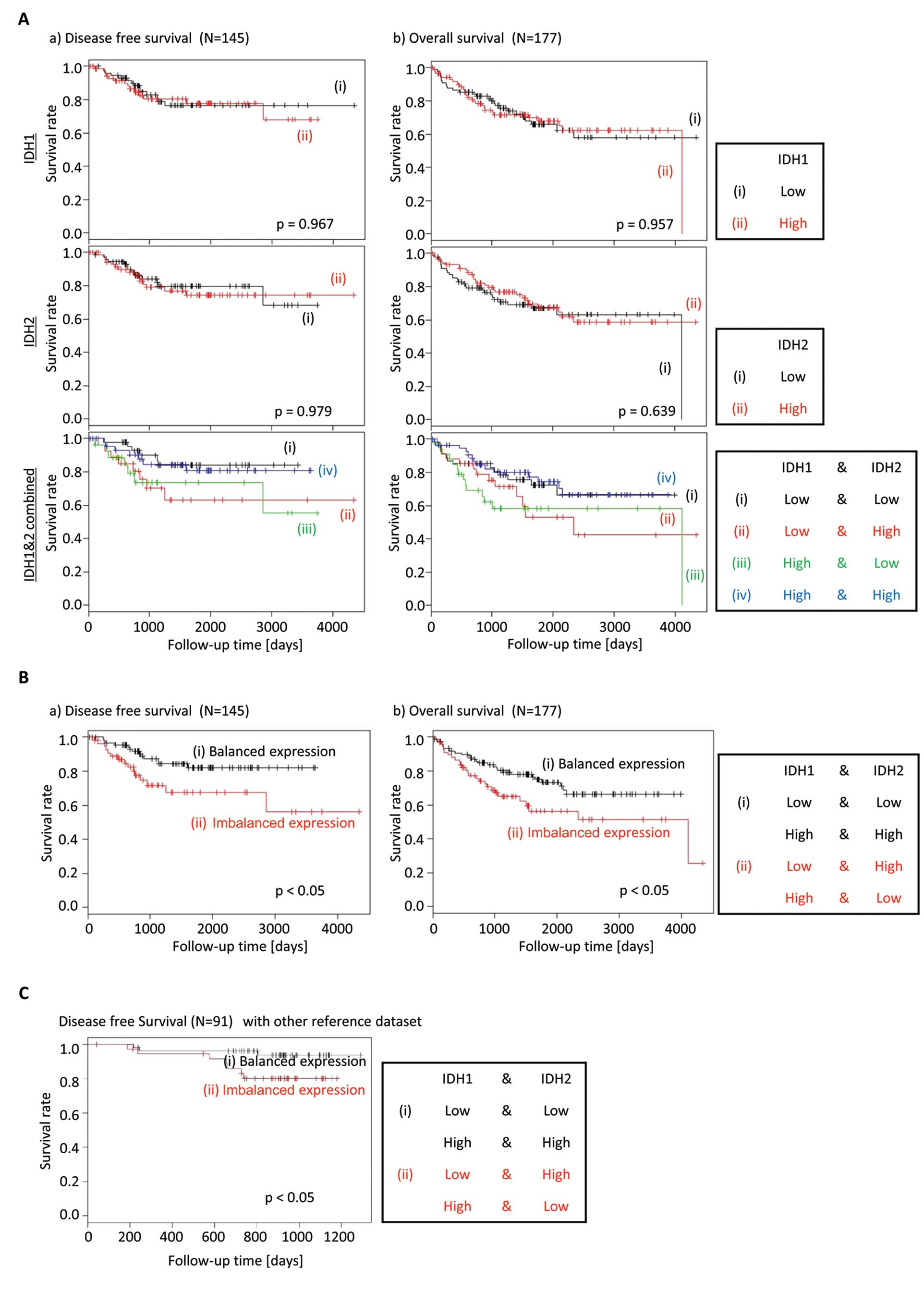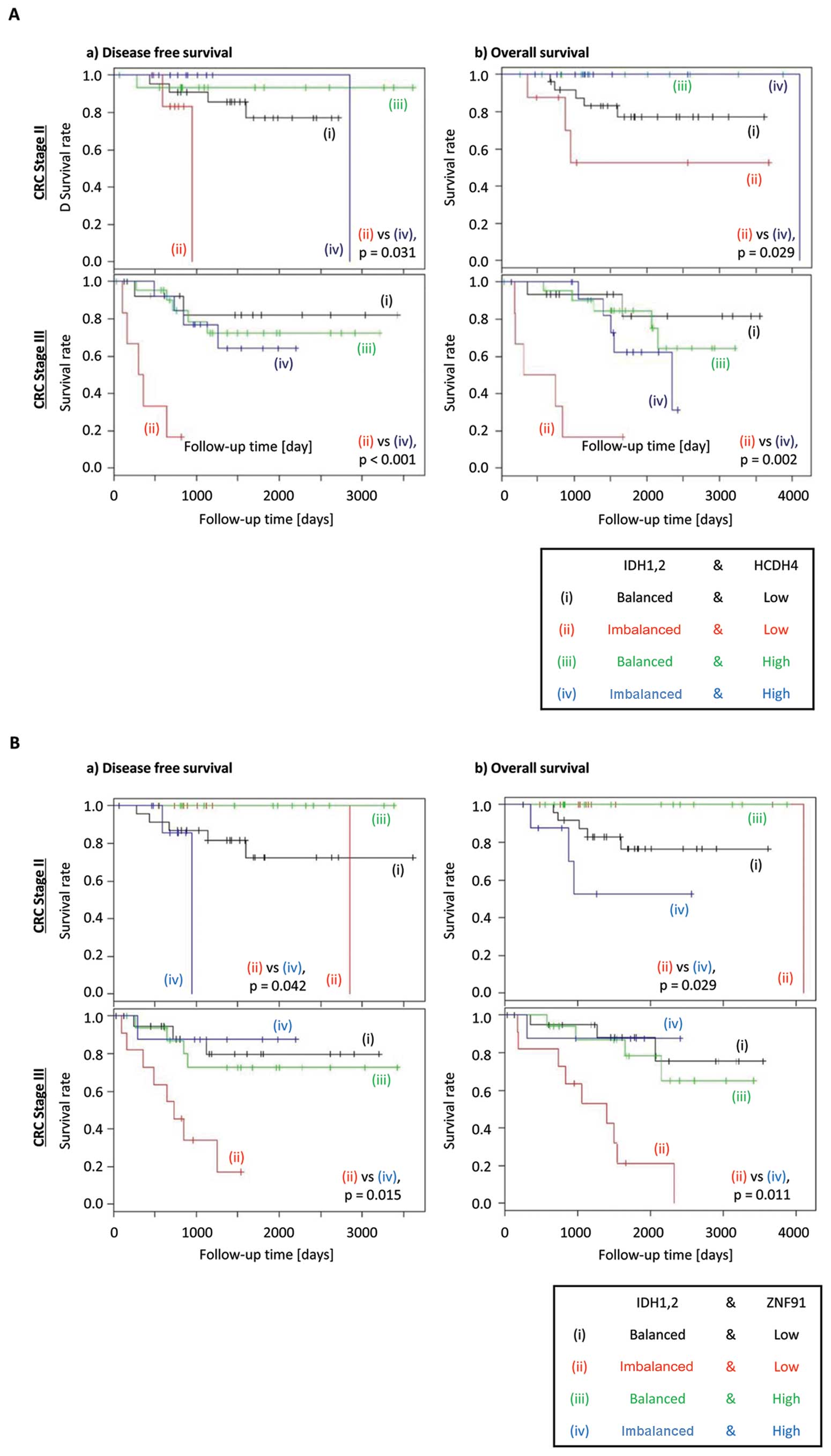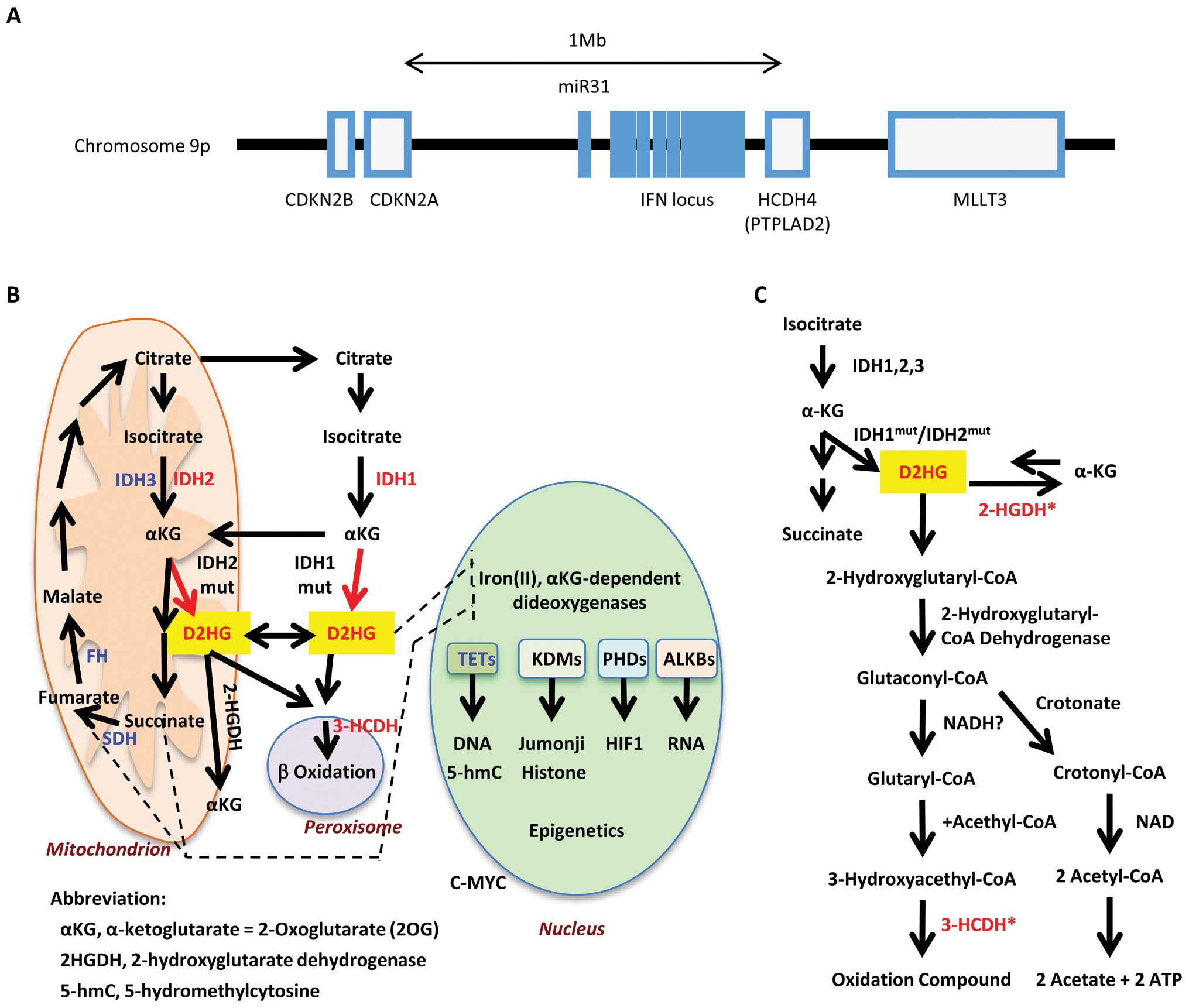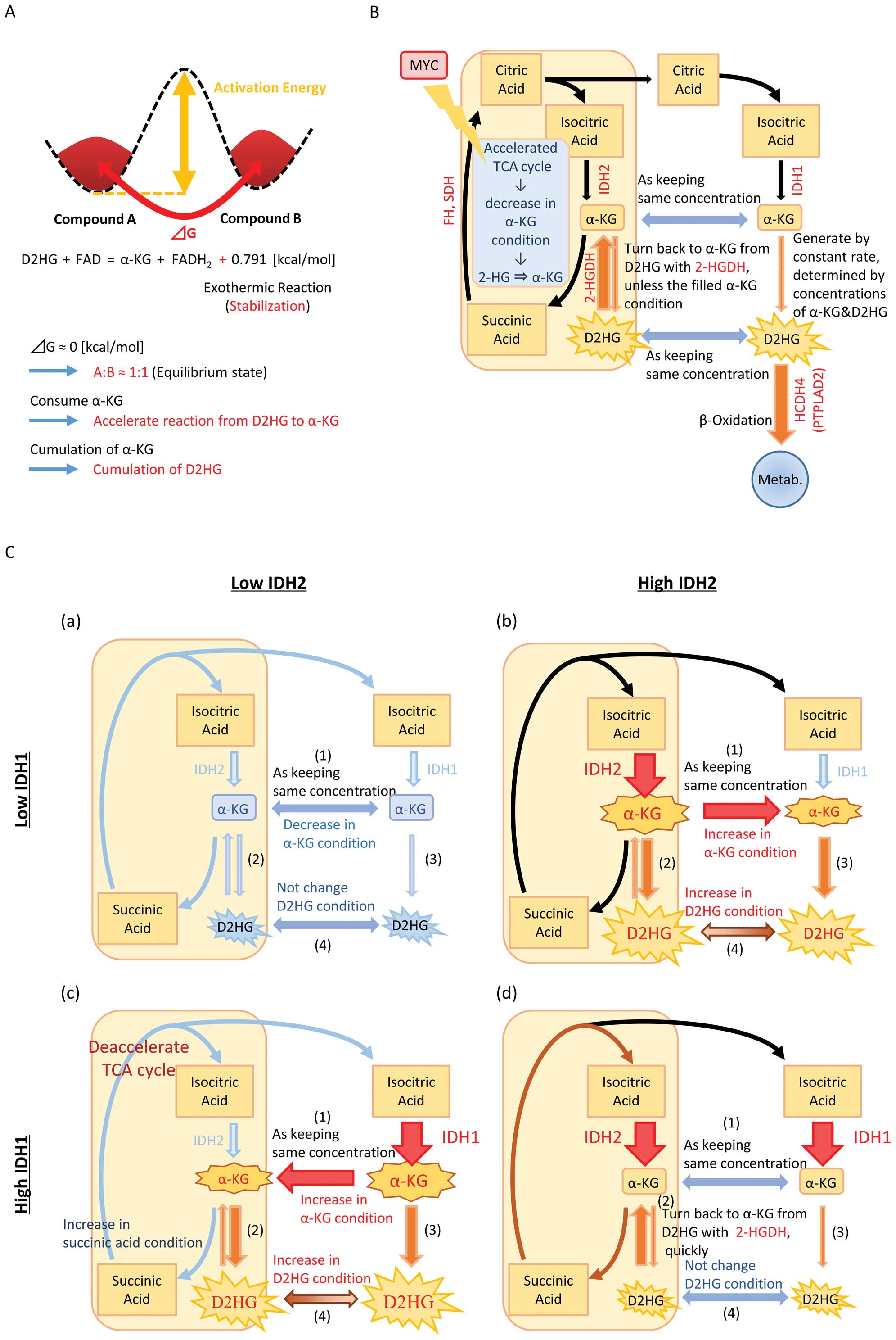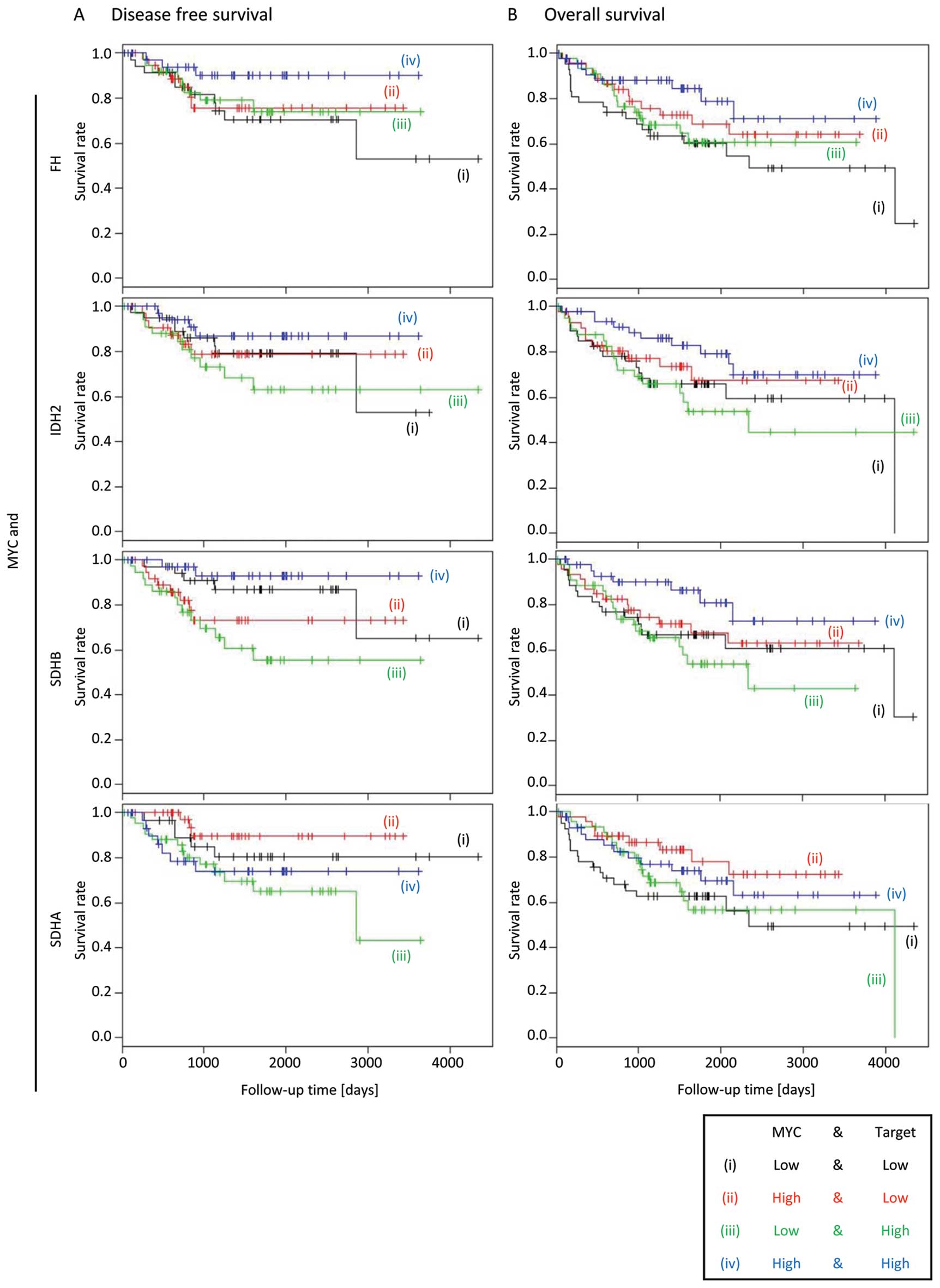Mathematical analysis predicts imbalanced IDH1/2 expression associates with 2-HG-inactivating β-oxygenation pathway in colorectal cancer
- Authors:
- Published online on: January 12, 2015 https://doi.org/10.3892/ijo.2015.2833
- Pages: 1181-1191
Abstract
Introduction
In the last few decades, there has been an exponential rise of the available biological data including human genomic sequences, gene expression profiles, protein-protein interaction networks, and metabolomic data of physiologically active compounds. This vast amount of information provides us with a challenging opportunity to develop computational approaches for systematic analysis of various disorders, including cancers, in order to utilize the biomedical data for prediction of patient prognosis, disease modeling and biological systems analysis (1). The genetic diversity in cancer is vast, given cancers can arise from most of the cells in the body (~6×1013 cells), and that tumors themselves also harbor heterogeneous cellular components (~1010 cells), including a subpopulation of cancer initiating cells (~108 cells) (2,3). The gene expression between cancer cells is also highly variable, this variability being generated through numerous mechanisms, including chromosomal translocations, genetic mutations, epigenetic chromatin remodeling of the 3×109 base paired DNA and alteration of histone structures (4–6). For example, sequencing analysis of liver cancer revealed that there are 11×103 genetic mutations, of which 10–100 are driver mutations, as well as 21 chromosomal structural abnormalities (7). Genetic heterogeneity occurs in many tumors (http://cancergenome.nih.gov), indicating that mathematical and statistical analysis is indispensable to distinguish between driver and passenger mutations in order to identify druggable targets.
In 2008 and 2009, two independent cancer sequencing projects reported high frequencies of mutations of the gene encoding the cytosolic enzyme IDH1, a critical component of the tricarboxylic acid (TCA) cycle, in glioblastoma multiforme (GBM) (8) and acute myeloid leukemia (AML) (9). Further study reported that IDH2, the gene encoding the homologous enzyme in the mitochondria was also frequently mutated in GBM patients (10). Studies indicated that >75% of grade 2 and 3 GBM and 20% of AML harbor mutations of IDH1 at R132, or IDH2 at the homologous R172 residue (11). These oncogenic mutations in IDH1 and IDH2 enzymes reduce their native activity, and generate neomorphic activity that converts α-ketoglutarate (α-KG; also known as 2-oxyoglutarate) to D-2-hydroxygutarate (D2HG) (12,13). D2HG is an oncome-tabolite that can cause changes to the epigenetic landscape by inhibiting the activities of iron (II), α-KG-dependent dioxygenases, including: prolyl-hydroxylase-domains (PHDs) resulting in pseudo-hypoxic environment and activation of hypoxia-inducible-factor (HIF) pathway leading to aberrant cellular proliferation; ten-eleven translocation (TET)-family demethylases, AlkB-family dioxygenases, which protect nucleotides against methylating reactions by directly dealkylating bases (1mA, 3mC, 1mG and 3mT); and histone lysine demethylases (KDMs) (14).
Other oncometabolites that have been identified are succinate and fumarate, which are generated by mutations of succinate dehydrogenase (SDH) and fumarate hydratase (FH), respectively. These also competitively inhibit α-KG-dependent dioxygenases (14), and moreover provide a strong rationale that TCA enzymes as a family may be important in other malignancies.
Here we applied computational analysis to study the association between gene expression profiles of colorectal cancer (CRC) patients and their prognosis. Using this approach, we identified that the imbalances between the expressions of IDH1 and IHD2 was associated with poorer prognosis of patients with CRC. Subsequent unsupervised analysis of targeted genes identified low expression of hydroxyl-CoA dehydratase (HCDH) 4 to amplify the effect of imbalanced IDH1 and IDH2 expressions on the survival of CRC patients. HCDH4 is an enzyme that metabolizes D2HG in the β-oxygenation pathway, and is encoded by a gene that is located at chromosome 9p21.3, which is frequently deleted in cancers alongside tumor suppressor INK4A and microRNA-31 (miR-31). The present computational analysis linked the association combining expression of IDH1 and IDH2, rather than mutations, with β-oxidization pathway in the prognosis of CRC patients.
Materials and methods
Gene Expression database of colorectal cancer patients
We used the published GSE17536 database (http://www.ncbi.nlm.nih.gov/geo/query/acc.cgi?acc=GSE17536) (15) from the Gene Expression Omnibus in NCBI to analyze the effects of gene expression on disease-free survival (DFS) and overall survival (OS) of CRC patients. This database contains the microarray data of 177 patients, generated using the Affymetrix Human Genome U133 Plus 2.0 Array. The microarray data were generated with multiple probes for one gene in some cases; if this was the case, the probe that demonstrated the widest variance of genetic expression amongst the cohort was selected for statistical analysis. Each selected gene was divided into low and high expression groups at the median point of expression. Additionally, to verify the relevance of our results with GSE17536 database, we used another reference dataset for CRC patients (16). The 91 patients with both CRC stage and DFS time information were selected from this reference dataset and used in validation analysis.
Analysis of the expression of genes of the oxidative phosphorylation pathway and their effect on the survival of colorectal cancer patients
Genes of the oxidative phosphorylation (OxPhos) pathway that are already known to be involved in neoplastic diseases were selected for initial analysis: TET 1–3 proteins, IDH1, IDH2, SDH, FH, MYC, glutaminase (GLS), and the mitochondrial alcohol dehydrogenase iron-containing 1 (ADHFE) (14). Genes in the above group were analyzed in all possible combinations as pairs in order to ascertain whether there were any associations between combined gene expressions and DFS or OS (Fig. 1). These analyses were conducted through the generation of Kaplan-Meier curves. Thirty-two patients were excluded from the analysis concerning the DFS given these were stated as being zero.
Screening for genes affecting the survival of colorectal cancer patients in a manner dependent on the expression of oxidative phosphorylation genes
Other genes that are associated with DFS and OS of CRC patients in a manner that is dependent on the selected genes of the OxPhos pathway were screened. The rationale for adopting this approach was to identify a biological pathway important in CRC, instead of emphasizing isolated gene expression. Only CRC patients with stages II or III were selected for this stage of analysis. Unbiased screening was performed for ‘the third genes’, searching for genes that do not have independent association with DFS or OS, but were nevertheless able to accentuate the effect of the selected OxPhos pathway genes on the DFS and OS (Fig. 1). Statistical analysis was performed; with statistical significance being defined when the p-value was <0.05. Kaplan-Meier curves were generated using the survival package (16) on R version 3.0.2 (17).
Results
Imbalance between the IDH1 and IDH2 expression is associated with decreased survival of colorectal cancer patients
The TCA cycle in mitochondria plays a critical role in OxPhos, which produces ATP via the electron transport chain (14). Given mutations of several of the OxPhos-related genes, such as families of TET proteins, IDH, SDH, and FH, are observed in human malignancies, we investigated whether the expression of these genes in combination as pairs would be associated with patient survival in CRC. Alterations of families of TETs, IDHs, SDHs, and FHs are expected to result in attenuation of α-KG-dependent dioxygenases, such as demethylases, which characterize cancers (14). There were no differences in the Kaplan-Meier curves for DFS or OS, when IDH1 or IDH2 expressions were analyzed in isolation. However, when the gene expression of IDH1 and IDH2 was analyzed together, the patients with an imbalance of IDH1 and IDH2 gene expression (i.e., IDH1high;IDH2low, or IDH1low;IDH2high), had a shorter DFS and OS compared to patients with a ‘balanced’ IDH gene expression (i.e., IDH1high;IDH2high, or IDH1low;IDH2low) (Fig. 2A and B).
We performed the same prognosis analysis for cancer recurrence with another reference dataset (16) to confirm that this biological behavior is not unique to the GSE17536 database. Also the validation results showed the same tendency that the patients with imbalanced expression of IDH1/2 had a shorter DFS compared to those with balanced expression (Fig. 2C), although this reference dataset is a small one, which has only 10 patients with relapsed cancer.
Reduced HCDH4 expression exacerbates the poor prognosis in colorectal cancer patients with imbalanced IDH expression
In order to identify novel partners of imbalanced IDH1 and IDH2 expression, we performed non-biased comparison against the total transcriptome data. Analysis was conducted in two steps, the first being to identify candidate genes that could separate the IDH1high:IDH2low and IDH1low:IDH2high patients from IDH1high:IDH2high and IDH1low:IDH2low patients in terms of the DFS and OS. Genes identified using this analysis were also checked for their ability to independently predict DFS or OS depending on their expression, and was excluded if this was the case. By using this approach, we identified 43 and 44 genes that had a significant effect on the DFS and OS, respectively (Table I). Of these ZNF91 (18,19) and HCDH4 [protein tyrosine phosphatase-like a domain containing 2 (PTPLAD2)] (20), were found to accentuate the reduction of both DFS and OS of CRC patients when IDH1 and IDH2 expression was imbalanced.
Table IGenes that have a significant effect on the DFS and OS, in a manner dependent on the imbalance between the expressions of IDH1 and IDH2.a |
When the above analysis was conducted further for individual stages of CRC, reduced expression of HCDH4 was shown to exacerbate the poorer DFS and OS in CRC patients with stages II or III disease (Fig. 3A). However, ZNF91 expression showed discordant effect on DFS and OS between different stages of CRC, with high expression associated with worse prognosis in stage II disease, but low expression is associated with worse prognosis in stage III disease (Fig. 3B). This result indicates that HCDH4 was more likely to be a suitable candidate for further analysis. HCDH4 is an enzyme that metabolizes D2HG in the β-oxygenation pathway. The genome data-base (http://www.ncbi.nlm.nih.gov/guide/genomes-maps/) shows that the HCDH4 gene is located at chromosome 9p21.3, which is a genomic region frequently deleted in cancer, also containing the tumor suppressor gene p16/CDKN2A/ INK4A. p16/CDKN2A/INK4A is inactivated by methylation of the gene promoter in early stages of gastrointestinal cancer (21). The gene locus containing p16/CDKN2A/INK4A and HCDH4 also harbors interferon genes and cancer-associated miR-31 (22), suggesting the alterations of this locus increases the susceptibility to cancer (Fig. 4A).
Prediction of a common pathway of IDH1, IDH2 and HCDH4 genes
Although the IDH expression changes analyzed in this study are likely to be associated with wild-type genes, we propose that an imbalance between the expressions of IDH1 and IDH2 could lead to the overproduction of D2HG, of which more will be explained in Discussion. Increasing the levels of the oncometabolite D2HG is potentially a common denominator of IDH1, IDH2 and HCDH4, with the decreased expression of the latter enzyme leading to reduced metabolism of D2HG. Therefore, D2HG provides an explanation for poorer survival of patients with imbalanced IDH1 and IDH2 as well as low HCDH4 expression. Previous studies have shown that HCDH is involved with the metabolization of D2HG in the glutaconyl pathway (http://www.genome.jp/kegg/) (Fig. 4). The direction of chemical reaction generally depends on the ΔG value instead of the activation energy. Given that the conversion from D2HG to α-KG is a relatively small exothermic reaction of 0.791 (kcal/mol) (calculated with MP2/6-31G level in Gaussian 09 package) (23), this suggests that D2HG is produced under physiological conditions, with IDH1 and IDH2 expression determining rate of production and D2HGDH and HCDH governing metabolization (Figs. 4C and 6A).
MYC overexpression is not associated with decreased survival of colorectal cancer patients
Recently, overexpression of the MYC oncogene occurring in a sub-group of breast cancer patients was shown to be associated with higher levels of D2HG and decreased survival. D2HG production was demonstrated to be driven by MYC overexpression in vitro, demonstrating a novel mechanism of D2HG production given IDH1 or IDH2 mutations in breast cancers are rare (24). In this cohort of CRC patients, MYC expression was not associated with decreased DFS or OS. Interestingly, the Kaplan-Meier analysis showed that patients with high MYC expression have better DFS or OS, regardless of the expression status of FH, IDH2 and SDHB (Fig. 5), suggesting that the role of MYC in CRC is distinct from that in breast cancers.
Discussion
In this study, an imbalance between the expression of IDH1 and IDH2 was associated with decreased DFS and OS in CRC patients; these reductions in DFS and OS were further accentuated by reduced expression of HCDH4. While previous investigations support the role of mutated forms of IDH and its importance in the pathophysiology of cancer, the link with the relative levels of expression between wild-type IDH1 and IDH2 in cancer survival is unprecedented. Mutated IDH1 and IDH2 have been implicated in causing cancer through the production of the oncometabolite D2HG (11). A recent study of hematopoietic malignancies show that the IDH2R140Q mutation was necessary alongside overexpression of Hox9A and Meis1a, or mutation of FMS-like tyrosine kinase 3 (FLT3), to initiate and maintain acute leukemia, most likely through increased levels of D2HG (25).
We postulate a role for D2HG in promoting CRC progression based on our current results, along with other recent published evidence. First, D2HG levels are raised in the tumors and plasma of mice with azoxymethane-induced intestinal cancer (26). Second, 5-hydroxymethylcytosine levels are decreased in human CRC, indicating decreased TET2 activity, which could reflect inhibition through high levels of D2HG (27).
We propose a model that explains how imbalanced IDH1 and IDH2 expression could lead to increased production of D2HG (Fig. 6B and C). In this scheme, we make several assumptions, including that both α-KG and D2HG are able to permeate between mitochondria and cell cytoplasm and equilibrate by osmosis. We also assume that the direction of chemical reaction depends on the difference of free energy between substances rather than the activation energy. When both IDH1 and IDH2 expressions are low, the production of α-KG is also low, leading to low levels of D2HG. When both IDH1 and IDH2 expressions are high, α-KG levels will rise due to increased production, but will either be metabolized effectively by the TCA cycle or be converted back to isocitric acid by the IDH enzymes, and the D2HG levels will remain low. When IDH1 expression is high and IDH2 expression is low, there will be increased production of α-KG in the cytoplasm, which will diffuse into the mitochondria by osmosis. In the absence of a high TCA cycle activity, the low level of IDH2 is not able to convert all of the α-KG into isocitric acid, resulting in the production of D2HG through a relatively small endothermic reaction. Similarly, when IDH2 expression is high and IDH1 expression is low, mitochondrial α-KG will diffuse into the cytoplasm, where the low levels of IDH1 is unable to convert all the α-KG into isocitric acid, instead leading to the production of D2HG.
We next focused on the relationship between MYC and components of the TCA cycle, given MYC has previously been reported to accelerate the TCA cycle. We proposed that the TCA cycle in an accelerated state is able to more efficiently metabolize α-KG, thereby preventing the production of D2HG and increasing the survival of CRC patients. As expected, high expression of MYC alongside high expression of the TCA cycle enzymes IDH2, FH and SDHB were associated with increased DFS and OS. However, the decreased DFS and OS when MYC and SDHA expression is high were inconsistent with the above notion. We are therefore preparing additional analysis concerning SDHA. The increased MYC expression associated with improved survival in this study is consistent with previous studies of CRC (28). In breast cancer however, increased MYC signaling was responsible for D2HG production and was associated with decreased survival (24), suggesting that MYC plays a different role to that in CRC.
HCDH4 is an enzyme that metabolizes D2HG in the β-oxygenation pathway and its mutation has been reported to cause hereditary peroxisomal disorders (20). Therefore the IDH enzymes together with HCDH4 affecting the prognosis of patients with CRC adds further support that D2HG is likely to play a role. Given that HCDH4 gene is located in the frequently deleted genomic region with tumor suppressor INK4A and miR-31 at chromosome 9p21.3, the inactivation of HCDH4 may contribute to CRC progression together with other oncogenic mutations.
The importance of D2HG in pathology is further demonstrated in a rare autosomal recessive neurometabolic disorder called D2HG aciduria (30). This condition occurs when D-2-hydroxyglutarate dehydrogenase (D2-HGHD), a mitochon-drial enzyme belonging to the FAD-binding oxidoreductase/transferase type 4 family, is mutated. This enzyme, which is most active in liver and kidney but also active in heart and brain, converts D2HG to α-KG. The condition is characterized by developmental delay, epilepsy, hypotonia, and dysmorphic features (29). Given multiple mechanisms are involved in metabolizing D2HG, this suggests the importance of maintaining D2HG levels low. Biochemical studies indicated that HCDH functions to inactivate D2HG via the glutaconyl pathway, whereas D-2-hydroxyglutarate dehydrogenase (D2-HGHD) is involved in the inactivation of physiological level of D2HG (http://www.genome.jp/kegg/) (Fig. 4B and C).
In order to be certain of the significance of IDH1 and IDH2 expression on the prognosis of colorectal cancer patients, the data requires validation using other cohorts of CRC patients, ideally with matched levels of D2HG. We are presently planning to evaluate D2HG levels in CRC patients.
This study provides direction for future studies and has demonstrated the following: i) the expressions of both IDH1 and IDH2, critical enzymes involved in oxidative phosphorylation in mitochondria, are associated with patient survival in CRC; ii) the usefulness of computational analysis of high volume data to suggest novel biological mechanisms and predict patient survival; iii) the benefit of the gene expression microarray for identifying potential novel therapeutic targets; iv) a link between IDH1, IDH2 and D2HG-inactivating β-oxidization pathway in CRC.
Acknowledgements
We thank Dr R. Daniel Beauchamp and Dr Pengcheng Lu, Vanderbilt Medical Center, TN, USA, for the critical review of our manuscript. This study was supported in part by a Grant-in-Aid for Scientific Research from the Ministry of Education, Culture, Sports, Science, and Technology; a Grant-in-Aid from the Third Comprehensive 10-year Strategy for Cancer Control, Ministry of Health, Labor, and Welfare; a grant from the Kobayashi Cancer Research Foundation; a grant from the Princess Takamatsu Cancer Research Fund, Japan; a grant from the National Institute of Biomedical Innovation; and a grant from the Osaka University Drug Discovery Funds. Partial support was received from Taiho Pharmaceutical Co., Ltd., EBMRCE, Chugai Co., Ltd., Yakult Honsha Co., Ltd. (J.K., N.N., M.K., K.K. and H.I.), Merck Co., Ltd., Takeda Science Foundation and Takeda Medical Research Foundation through institutional endowments.
References
|
Chena M and Hofestädtb R: A medical bioinformatics approach for metabolic disorders: Biomedical data prediction, modeling, and systematic analysis. J Biomed Inform. 39:147–159. 2006. View Article : Google Scholar | |
|
Reya T, Morrison SJ, Clarke MF and Weissman IL: Stem cells, cancer, and cancer stem cells. Nature. 414:105–111. 2001. View Article : Google Scholar : PubMed/NCBI | |
|
Meacham CE and Morrison SJ: Tumour heterogeneity and cancer cell plasticity. Nature. 501:328–337. 2013. View Article : Google Scholar : PubMed/NCBI | |
|
Nowell PC and Croce CM: Chromosomes, genes, and cancer. Am J Pathol. 125:8–15. 1986. | |
|
Kouzarides T: Chromatin modifications and their function. Cell. 128:693–705. 2007. View Article : Google Scholar : PubMed/NCBI | |
|
Yaniv M: Chromatin remodeling: from transcription to cancer. Cancer Genet. Mar 21–2014.(Epub ahead of print). View Article : Google Scholar : PubMed/NCBI | |
|
Fujimoto A, Totoki Y, Abe T, et al: Whole-genome sequencing of liver cancers identifies etiological influences on mutation patterns and recurrent mutations in chromatin regulators. Nat Genet. 44:760–764. 2012. View Article : Google Scholar : PubMed/NCBI | |
|
Parsons DW, Jones S, Zhang X, et al: An integrated genomic analysis of human glioblastoma multiforme. Science. 321:1807–1812. 2008. View Article : Google Scholar : PubMed/NCBI | |
|
Mardis ER, Ding L, Dooling DJ, et al: Recurring mutations found by sequencing an acute myeloid leukemia genome. N Engl J Med. 361:1058–1066. 2009. View Article : Google Scholar : PubMed/NCBI | |
|
Yan H, Parsons DW, Jin G, et al: IDH1 and IDH2 mutations in gliomas. N Engl J Med. 360:765–773. 2009. View Article : Google Scholar : PubMed/NCBI | |
|
Cairns RA and Mak TW: Oncogenic isocitrate dehydrogenase mutations: mechanisms, models, and clinical opportunities. Cancer Discov. 3:730–741. 2013. View Article : Google Scholar : PubMed/NCBI | |
|
Dang L, White DW, Gross S, et al: Cancer-associated IDH1 mutations produce 2-hydroxyglutarate. Nature. 462:739–744. 2009. View Article : Google Scholar : PubMed/NCBI | |
|
Ward PS, Patel J, Wise DR, et al: The common feature of leukemia-associated IDH1 and IDH2 mutations is a neomorphic enzyme activity converting alpha-ketoglutarate to 2-hydroxyglutarate. Cancer Cell. 17:225–234. 2010. View Article : Google Scholar : PubMed/NCBI | |
|
Ponnaluri VK, Maciejewski JP and Mukherji M: A mechanistic overview of TET-mediated 5-methylcytosine oxidation. Biochem Biophys Res Commun. 436:115–120. 2013. View Article : Google Scholar : PubMed/NCBI | |
|
Smith JJ, Deane NG, Wu F, Merchant NB, et al: Experimentally derived metastasis gene expression profile predicts recurrence and death in patients with colon cancer. Gastroenterology. 138:958–968. 2010. View Article : Google Scholar | |
|
Takatsuno Y, Mimori K, Yamamoto K, et al: The rs6983267 SNP is associated with MYC transcription efficiency, which promotes progression and worsens prognosis of colorectal cancer. Ann Surg Oncol. 20:1395–1402. 2013. View Article : Google Scholar | |
|
Therneau TM and Grambsch PM: Modeling Survival Data: Extending the Cox Model. Springer; NY: 2000 | |
|
Team RC: A language and environment for statistical computing. R Foundation for Statistical Computing; Vienna: 2013, http://www.R-project.org/. | |
|
Unoki M, Okutsu J and Nakamura Y: Identification of a novel human gene, ZFP91, involved in acute myelogenous leukemia. Int J Oncol. 22:1217–1223. 2003.PubMed/NCBI | |
|
Micci F, Skotheim RI, Haugom L, et al: Array-CGH analysis of microdissected chromosome 19 markers in ovarian carcinoma identifies candidate target genes. Genes Chromosomes Cancer. 49:1046–1053. 2010. View Article : Google Scholar : PubMed/NCBI | |
|
Suzuki Y, Jiang LL, Souri M, et al: D-3-hydroxyacyl-CoA dehydratase/D-3-hydroxyacyl-CoA dehydrogenase bifunctional protein deficiency: a newly identified peroxisomal disorder. Am J Hum Genet. 61:1153–1162. 1997. View Article : Google Scholar : PubMed/NCBI | |
|
Bian YS, Osterheld MC, Fontolliet C, Bosman FT and Benhattar J: p16 inactivation by methylation of the CDKN2A promoter occurs early during neoplastic progression in Barrett’s esophagus. Gastroenterology. 122:1113–1121. 2002. View Article : Google Scholar : PubMed/NCBI | |
|
Alder H, Taccioli C, Chen H, et al: Dysregulation of miR-31 and miR-21 induced by zinc deficiency promotes esophageal cancer. Carcinogenesis. 33:1736–1744. 2012. View Article : Google Scholar : PubMed/NCBI | |
|
Frisch MJ, Trucks GW, Schlegel HB, et al: Gaussian 09. Gaussian, Inc; Wallingford, CT: 2009 | |
|
Terunuma A, Putluri N, Mishra P, et al: MYC-driven accumulation of 2-hydroxyglutarate is associated with breast cancer prognosis. J Clin Invest. 124:398–412. 2014. View Article : Google Scholar : | |
|
Kats LM, Reschke M, Taulli R, et al: Proto-oncogenic role of mutant IDH2 in leukemia initiation and maintenance. Cell Stem Cell. 14:329–341. 2014. View Article : Google Scholar : PubMed/NCBI | |
|
Montrose DC, Zhou XK, Kopelovich L, et al: Metabolic profiling, a noninvasive approach for the detection of experimental colorectal neoplasia. Cancer Prev Res Phila. 5:1358–1367. 2012. View Article : Google Scholar : PubMed/NCBI | |
|
Haffner MC, Chaux A, Meeker AK, et al: Global 5-hydroxy-methylcytosine content is significantly reduced in tissue stem/ progenitor cell compartments and in human cancers. Oncotarget. 2:627–637. 2011.PubMed/NCBI | |
|
Smith DR and Goh HS: Overexpression of the c-myc proto-oncogene in colorectal carcinoma is associated with a reduced mortality that is abrogated by point mutation of the p53 tumor suppressor gene. Clin Cancer Res. 2:1049–1053. 1996.PubMed/NCBI | |
|
Struys EA, Salomons GS, Achouri Y, et al: Mutations in the D-2-hydroxyglutarate dehydrogenase gene cause D-2-hydroxy-glutaric aciduria. Am J Hum Genet. 76:358–360. 2005. View Article : Google Scholar : |




